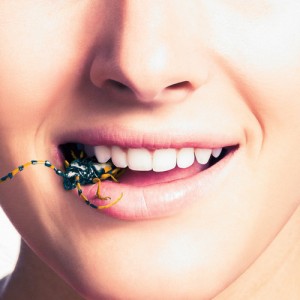
Cart
Unusual Gift | How to eat edible bugs
Eating Bugs, a new dietary approach

'Entomophagy' is a word yet unknown to the general public. It refers to the consumption of edible insects by human beings.
For convenience, spiders, scorpions and other centipedes have been included in the scope of its meaning, even though they are not part of the insect species. Entomophagy is practice common in many countries. For cultural, culinary, economic and ecological reasons, they have begun to slowly appear in French food. People eating bugs call themselves "entomophages".
Entomophagy has many advantages
Not the least being its nutritional values. Nutritional qualities of edible insects have been time and again demonstrated. They are full of proteins, minerals and vitamins.
In addition to that, they also contain low levels of saturated fat, therefore providing your body with fewer calories. Once dried, their protein content is even several times greater than fresh meat and fish. For example, some bee larvae can deliver ten times more D-vitamin than cod liver oil. Their taste is not something you forget, too. There are hundreds of different varieties of delicious edible insects you can cook quickly and easily. Some like them plain, others seasoned. It is only a matter of taste and personal preferences. We will come back to that later.
They have also proven themselves to be eco-friendly as edible insects farming is far less destructive and polluting than traditional farming. Edible bugs require three times less food on average than cattle in order to produce one kilogram of proteins. They are also an endless source of food. Did you know insect biomass is roughly 80% of all animal biomass on our planet? They truly are an effective answer to human malnutrition. And with overpopulation looming on the horizon, something happening in the coming decades, we desperately need solutions.
They breed easily, in abundance and confined spaces don't bother them. Unlike beef or mutton, bugs do not require heavy industrial equipment or lots of preparation. Much cleaner, some species emit 99% less greenhouse gas than cattle. And large scale farming of edible bugs would limit animals sufferance as well as meet the nutritional needs of a population growing exponentially and would be far more eco-friendly than any other kind of livestock farming ever invented until today. Insect farming is a credible answer to contemporary problems and is undoubtedly a compelling alternative to effectively answer the looming humanitarian and ecological crisis.
In Europe, how 'eating bugs' is interpreted?
Although entomophagy is part of human history, our Western culture distanced us this kind of diet. But many people around the world still practice entomophagy. Everyday consumption of edible insects is common all across South-america, Africa and Asia, where caterpillars, termites, larvae, worms, grasshoppers and spiders are cooked and eaten without making a fuss.
In Europe, though, this subject is quite controversial for consumer. Products like oysters, snails and frog legs are maybe on the menu but Westerners perception of edible insects as a food source is still sketchy, at best. They see them as useful companions to biodiversity and that's about it. We are still reluctant to think adding insects on the menu could be quite beneficial.
Indeed, insects' unsavory aspect doesn't really appeal to us. In addition to that, the same education we were taught by our parents since childhood gave us a negative image of them. Eating bugs as a recreational activity recently began making its way across Europe though. And for entirely valid reasons. By tirelessly bringing European consumers with irrefutable scientific proofs, they have begun to see insects from a different angle altogether. What seemed to them like a new fad is actually changing into a powerful conviction towards better tomorrows.
Communities of entomophages (people eating edible bugs) began to form and to share experiences together. Websites specialized in edible insects marketing put them on sale and many astonishing insects appeared on the market. We could highlight some of the most successful of them, like http://www.insectescomestibles.fr, a website offering recipes, hosting events or setting up a workshop inside your home or in your business' place. And actually selling some edible bugs too!
Get advices on how to eat bugs!
There exist lots of differents insects species in the world, but not all of them are edible. Last estimates put them at about one millions for which only two thousands are truly edible. Beyond toxicity, there is also the risk of eating infected or diseased species for which, just a taste point would poison your experience of entomophagy, really a shame. Needless to say, it is imperative for you to pass through professionals for your purchases. Especially if you don't have a thorough knowledge of which species can be safely eaten.
Rely on professionals guidance and direct you to the easiest and safest species and to point you to the best recipes, a sure way to delight your taste buds.
As you can see, eating bugs is not a mere trend soon to fade. It is a food likely to stay a long time and that will profoundly change how we see tomorrow's food. Since the dawn of time, men have been able to understand how interesting these small creatures are to our environment, but they certainly couldn't p.
Today more than ever, edible insects are undeniably a potential for good. Especially because they are likely going to save the human species with its major demographic challenges and its tendency to destroy itself by over-consuming. Be aware that by eating them, you will take part in a wonderful adventure towards collective awareness and help promote a necessary food transition. And really, what other opportunity exists for us to engage into that associates ecological, economic and gastronomical concerns?





